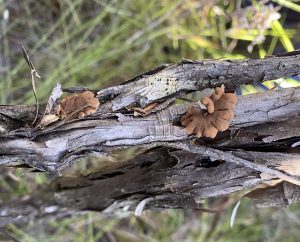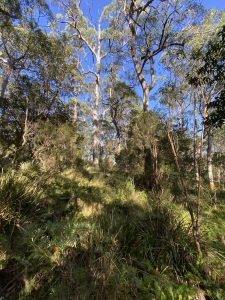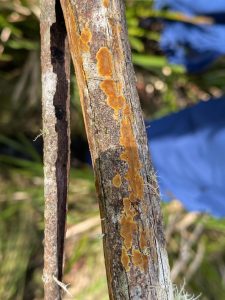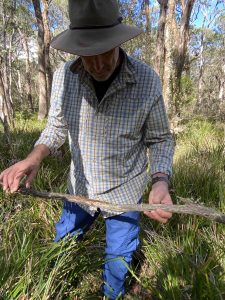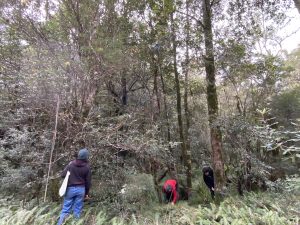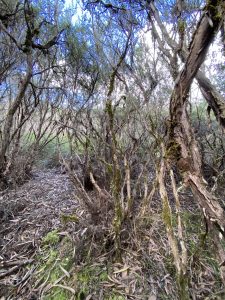For over a decade there has been the possibility that the critically endangered fungus Tea-tree Fingers (Hypocreopsis amplectens or TTF) has been living in New England National Park. A record of the elusive fungus was sent to Fungimap in 2015 by a new fungi enthusiast Maria had seen a picture of TTF in their book Fungi Down Under (1997). She was excited as she had taken a picture of this species in New England National Park during an autumn visit in 2013. Everyone was excited, so much so that Maria revisited the park that year but couldn’t find TTF but she was able to send a habitat shot that was quiet different from the heathy woodlands that are it’s preferred habitats in the Victorian populations.
- This is what Tea-tree Fingers looks like from one of the French Island heathy thicket sites (SJM McMullan-Fisher)
- Fabulous tall open Eucalypt forest near where TTF was seen in 2013 (SJM McMullan-Fisher).
The opportunity arose as Sapphire had the opportunity to work with Dr Andrew Thornhill and Dr Teresa Lebel on a new field intensive unit at the University of New England focused on Mosses and Mushrooms. Interestingly the likely host fungus was found at least twice in more rainforest habitats around Mt Hyland. We took these freshly trained students who now were able to recognise fungi, including lichens, mosses and other bryophytes like liverworts and hornworts. So 22 people carefully searched on every branch, shrub, tree, twig in the area of tall forest with a shrubby understorey. They wanted to find this critically endangered fungus but we didn’t want to be a negative impact so care was taken to not damage the area. The this many people searching for just over half an hour reached total time amounted to a wapping 720 minutes (or 12 hours). I think this is the largest team searching together to date.
TTF has most commonly been found on the dead branches often still attached to the shrub but sometimes even on living shrubs. Most common host plants are the Tea-trees, (Leptospermum), paperbarks (Melaleucas) and Yarra Burgan (Kunzea leptospermoides). As well as Tea-trees the other plant hosts in the park were the larger leaved Tree Broom-Heath (Monotoca elliptica) was more common, with some of the smaller Prickly Broom Heath (Monotoca scoparia), some other heaths (Leucopogons) plus several Banksia species. From the two New Zealand TTF records in Canterbury we know that it can occur in Cool Temperate Rainforest, so the we hope that this New England warmer rainforests and surrounding forests and thickets may also be its home.
As well as looking for TTF itself everyone was look for the host fungi – these are often tricker to see as they often reproduce on the underside of twigs, branches and stags (standing dead wood). The host fungus Hymenochaete was found 10 times during the searches. The count for the host fungi is based on the number of individual branches or other plant substrates, nine of these were the reproductive structures of the Hymenochaete as seen in the image and once was the golden binding mycelium that can be found sticking branches and litter together.
- Host fungus Hymenochaete grows on the underside of branches (SJM McMullan-Fisher
- Professor Karl Vernes from University of New England helped with searches (SJM McMullan-Fisher)
We hoped we would strike it lucky with the UNE students but we couldn’t be sure. So a smaller team of searches spent the weekend enjoying the fabulous environments while looking for TTF. This team consisted of Shari, our best spotter from Victoria drove up to meet Teresa, Ema and Sapphire stayed after the UNE course. We were also joined by environmental journalist Whitney Bauck who flew from the USA to join our mycological conservation crew.
- Ema, Teresa & Whitney searching in the rainforest edge (SJM McMullan-Fisher)
- Swampy thicket habitat was similar to many Victorian populations (SJM McMullan-Fisher)
We stayed at the comfortable but rustic Tom’s Cabin for 3 nights it was our base for searches and bush walks when the intensity of searches got too much. We had additional eyes on Sunday morning when Prof Karl Vernes joined us. He claimed to be a humble zoologist but he was spotting host fungi along with the rest of us. We spent that morning looking in the more Tea-tree dominated habitats below Maria’s original site. These were very dense thickets, with some host fungi. We even saw some reproducing slime moulds but no TTF.

These dots are where we searched for TTF and its host fungi and plants, we stayed in the wetter habitats(SJM McMullan-Fisher)
All up on the weekend we added 1732 minutes (29 hours) of search time. We enjoyed our time looking, we even saw the local sea eagle soaring overhead. We covered as much of the likely habitats near the original sighting as we could (see dots on map), but the park is so rich in potential plant and fungi hosts that too much likely looking areas were not searched.
Next time we need to take a local botanist with us as we are not sure which of the 6 species of tea-tree Leptospermum spp. found in the park we were searching under!
If people do have patches of Tea-tree they too could look for TTF. If you do look we want where possible pictures of both plant hosts of TTF and fungi hosts of TTF, along with search efforts (how many minutes you were looking in the area) please share it to this iNaturalist project. This shows us places we think are likely habitat for TTF. If host fungus is also found it is well worth knowing.
There were several habitats that contained host fungus and likely host plants for TTF in New England National Park. So although we didn’t see Tea-tree Fingers itself we are reassured that there is good habitat with host fungus for it to live off so hopefully there is still a population waiting to be found.
